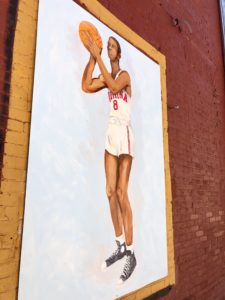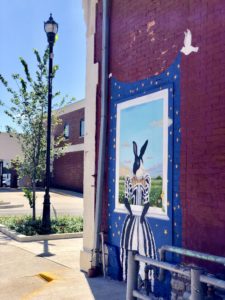Main Street Alleyway Murals
Main Street Alleyway Murals
What influences a resident’s decision to stay in Shelby County, Indiana? What factors keep people who work in Shelby County from making their homes there? The Blue River Community Foundation (BRCF) in Shelbyville, Indiana, posed these questions in a recent survey and found that a lack of arts and cultural options in the county drove…
Location
Shelbyville, Indiana
Partners
Mainstreet Shelbyville and Blue River Community Foundation
Public Funding Includes
Indiana Office of Community and Rural Affairs: Quick Impact Placebased (QuIP) grant
What influences a resident’s decision to stay in Shelby County, Indiana? What factors keep people who work in Shelby County from making their homes there? The Blue River Community Foundation (BRCF) in Shelbyville, Indiana, posed these questions in a recent survey and found that a lack of arts and cultural options in the county drove many people to settle elsewhere. In light of this revelation, the foundation teamed with Mainstreet Shelbyville to bring the arts closer to daily life in Shelby County.

Photos courtesy of Blue River Community Foundation
Around the same time, an empty alley near Shelbyville’s downtown Public Square presented a prime opportunity. A class of Leadership Shelby County – a leadership development program for local civic, business and nonprofit leaders – had chosen to renovate the alley as a team project. They convinced the city to convert the alley from a roadway to a pedestrian thoroughfare and put in sidewalks and benches. Once the Leadership class term ended, however, the project stalled. The space remained inactive and uninviting. Jennifer Jones, BRCF executive director, saw strong potential in taking over the alley project and activating the space with artwork to accomplish “downtown creative placemaking with a Main Street focus.” Jordan England, who is BRCF’s grants and nonprofit relations director and the former program coordinator for Mainstreet Shelbyville, agreed: “We had the empty canvas of the brick walls; we just needed the art.”
The two organizations used a small amount of private funding to start work on the alley, but they needed more resources. BRCF found an opportunity in the Indiana Arts Commission’s e-mail newsletter: the Quick Impact Placebased (QuIP) grant program, administered by the state Office of Community and Rural Affairs in partnership with the Indiana Arts Commission. Intended specifically for Main Street communities, the QuIP program awards grants up to $5,000 to support “space enhancement and community transformation that sparks community wide conversation and creativity.” The Arts Commission’s e-mail was timely. “We were at an advantage because we were already working on a public art plan,” Jones said, “so once we saw what they had available, we didn’t have to come up with a new project” to fit the opportunity. QuIP’s combined focus on arts and Main Street made it an ideal resource for an alleyway mural project in the heart of Shelbyville.

Photos courtesy of Blue River Community Foundation
With QuIP’s minimal restrictions on the use of funds, Mainstreet Shelbyville used its $5,000 grant to pay muralist Greg Potter. True to their ultimate goal to make Shelby County an appealing place to call home, the alleyway project is modeled after a hallway in an older home. The walls of the “hallway” will be lined with Potter’s mural depicting portraits of Shelby County natives who are famous outside the area. Four portraits have been completed so far: basketball player William Garrett, who broke the color barrier in the Big Ten Conference; cartoon character Bucky Barnes, the Captain America sidekick whose comic-book backstory gives his hometown as Shelbyville; Sandy Allen, the world’s tallest woman at 7 feet-7 inches; and a rabbit that pays homage to 19th-century author Charles Major.
The portraits are already receiving attention from passersby and patrons of restaurants with an entrance along the alley. “People are definitely enjoying the artwork,” said England. “Our community so far has responded really well.” The project has attracted not only attention, but additional funding. The QuIP award gave Mainstreet and BRCF confidence to move the project forward by seeding early work and giving the effort visibility and momentum. “Now there are other people wanting to be involved and fund this,” England said. BRCF received funding from Lilly Endowment through the Giving Indiana Funds for Tomorrow grant program to support the planning work for the alley. And the Indiana Grand Casino, the area’s biggest employer, approached Mainstreet Shelbyville to discuss a significant donation. Casino management were impressed with what they’d seen of the project so far. While the QuIP grant required a 50% local match, Mainstreet Shelbyville has been able to leverage far more from the initial QuIP investment. In fact, the state’s QuIP grant now accounts for only about 10% of the project budget.
Jones advises grant seekers to have a realistic, but flexible, plan and budget. Mainstreet Shelbyville’s initial plan for the alleyway project grew and evolved as it received more public feedback and interest. Therefore, Jones explains, Mainstreet and BRCF decided to create their ideal vision for the project and scale it back, if necessary, rather than starting small and adding new elements and funding piecemeal. This concrete plan and well-established partnerships helped Mainstreet Shelbyville seize the QuIP opportunity as soon as it surfaced. “We had several different players in the game before this, so there wasn’t a lot of buy-in we had to get” for the QUIP application, England said. The city’s planning department, BRCF and Mainstreet Shelbyville were already working together on a shared vision for the alley project, which saved England the time and effort of convening stakeholders before applying for the state grant and other funding. “You need partners,” Jones agreed, “not just financially, but to support you and say they think this project is needed and will be successful in your community. It was all there. We just had to fill out the application.”

Photos courtesy of Blue River Community Foundation
The shared vision is clear, accessible and unique to its location. “One of our goals was improving quality of life in Shelby County and making sure people want to live here,” Jones said. To that end, the alleyway artwork is not just any mural. It’s one that fosters pride of place and a sense of belonging. “Because the art depicts famous people from Shelby County, it’s personal for the people who live here.” The vision doesn’t end with the mural, however. Mainstreet is now working with a metal fabricating company to create frames for the portraits and chandeliers to bring lighting to the alley, and potentially design new benches that better suit the historic home aesthetic of the space.
There will be several empty frames when the first set of portraits is finished. Blue River Community Foundation intends to create a program through which local artists fill those frames with portraits of local people who are notable in their own right, such as teachers, doctors, and public servants. These portraits will be interchangeable and England hopes the rotating set of portraits continues to draw activity to the alleyway. “For us, it’s important to continue getting people downtown,” she said. “It will be another stop on their trip to go see what’s new in the alley.”

